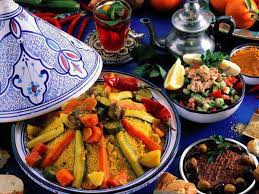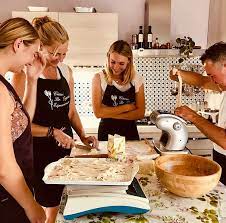Exploring the Flavours of Morocco: Typical Moroccan Food
When it comes to culinary delights, Morocco is a treasure trove of vibrant flavours, aromatic spices, and mouth-watering dishes that tantalise the taste buds. From tagines to couscous, Moroccan cuisine is a reflection of the country’s diverse cultural influences and rich history.
Tagine
One of the most iconic dishes in Moroccan cuisine is the tagine. Named after the earthenware pot in which it is cooked, a tagine typically consists of slow-cooked meat (such as lamb or chicken), vegetables, dried fruits, and a blend of spices that create a harmonious blend of sweet and savoury flavours.
Couscous
Couscous is another staple in Moroccan households. This fluffy semolina dish is often served with a variety of toppings such as vegetables, chickpeas, and tender meat simmered in a flavourful broth. Couscous plays a central role in Moroccan gatherings and celebrations.
Moroccan Mint Tea
No meal in Morocco is complete without a refreshing glass of Moroccan mint tea. Served hot and sweetened with sugar, this traditional drink is not only a symbol of hospitality but also a delightful way to cleanse the palate after indulging in rich and spicy dishes.
Pastilla
For those with a taste for something unique, pastilla is a must-try Moroccan delicacy. This savoury-sweet pastry combines layers of thin dough filled with spiced meat (often pigeon or chicken), almonds, eggs, and cinnamon—a true fusion of flavours that will leave you craving more.
Harira
Harira is a hearty soup that holds a special place in Moroccan cuisine, especially during Ramadan. Made with tomatoes, lentils, chickpeas, herbs, and spices, this comforting soup provides nourishment and warmth to break the fast at sunset.
Briouats
Briouats are delectable stuffed pastries that come in various forms—sweet or savoury. Whether filled with spiced minced meat or almond paste flavoured with orange blossom water, these crispy delights are perfect for enjoying as an appetiser or dessert.
Exploring typical Moroccan food is not just about satisfying your hunger; it’s an immersive experience that offers insight into the country’s vibrant culture and traditions. From communal meals shared around a tagine to sipping mint tea on bustling souk streets—Moroccan cuisine invites you to savour every bite with all your senses.
Exploring Moroccan Cuisine: Popular Dishes, Spices, and Traditional Meals
- What are the most popular Moroccan dishes?
- What spices are commonly used in Moroccan cuisine?
- Is Moroccan food typically spicy?
- What is a traditional Moroccan meal like?
- Are there vegetarian options in Moroccan cuisine?
- How is couscous traditionally prepared in Morocco?
- What drinks are commonly served with Moroccan meals?
What are the most popular Moroccan dishes?
When it comes to popular Moroccan dishes, a few culinary gems shine brightly on the country’s gastronomic scene. Tagine, with its tender meat and aromatic blend of spices, stands out as a beloved classic that embodies the essence of Moroccan cuisine. Couscous, a staple dish that brings together fluffy semolina and a medley of vegetables or meats, is a comforting favourite enjoyed by many. Moroccan Mint Tea holds a special place as a ubiquitous beverage that symbolises hospitality and tradition. These iconic dishes, along with delicacies like pastilla and harira soup, showcase the rich tapestry of flavours that make Moroccan food so enticing and unforgettable.
What spices are commonly used in Moroccan cuisine?
One frequently asked question about typical Moroccan food is, “What spices are commonly used in Moroccan cuisine?” Moroccan cuisine is renowned for its bold and aromatic flavours, which are achieved through a unique blend of spices. Some of the most commonly used spices in Moroccan cooking include cumin, cinnamon, paprika, turmeric, ginger, saffron, and coriander. These spices not only add depth and complexity to dishes like tagines and couscous but also reflect the country’s historical trade routes and cultural influences.
Is Moroccan food typically spicy?
In response to the frequently asked question about whether Moroccan food is typically spicy, the answer lies in the diverse palette of flavours found in Moroccan cuisine. While spices play a significant role in enhancing the taste of dishes, not all Moroccan food is overly spicy. The use of a blend of aromatic spices such as cumin, paprika, cinnamon, and ginger adds depth and complexity to the dishes without necessarily making them overly hot. Moroccan cuisine strikes a delicate balance between savoury, sweet, and aromatic notes, offering a culinary experience that caters to a range of preferences beyond just spiciness.
What is a traditional Moroccan meal like?
A traditional Moroccan meal is a feast for the senses, offering a captivating blend of flavours, textures, and aromas that reflect the country’s rich culinary heritage. At the heart of a Moroccan meal is often a communal dish such as a tagine or couscous, shared among family and friends gathered around a table. These dishes typically feature tender meat or vegetables cooked with an array of spices, dried fruits, and nuts, creating a harmonious balance of sweet and savoury notes. Accompanied by freshly baked bread, olives, and Moroccan salads, a traditional meal in Morocco is not just about nourishment but also about celebrating the art of hospitality and togetherness through food.
Are there vegetarian options in Moroccan cuisine?
In Moroccan cuisine, there are plentiful vegetarian options that showcase the diverse and vibrant flavours of the country. From hearty vegetable tagines bursting with spices to fragrant couscous dishes adorned with seasonal produce, vegetarians will find a plethora of delicious choices to savour. Traditional dishes like chickpea-based harira soup, flavourful stuffed bell peppers, and crispy briouats filled with spinach and cheese cater to those seeking meat-free alternatives. With its emphasis on fresh ingredients and bold spices, Moroccan cuisine offers a delightful array of vegetarian delights that are sure to please even the most discerning palates.
How is couscous traditionally prepared in Morocco?
In Morocco, couscous is traditionally prepared with meticulous care and attention to detail. The process typically begins by hand-rolling durum wheat semolina into tiny granules, which are then steamed multiple times in a special pot called a couscoussier. This steaming process ensures that the couscous remains light and fluffy. The dish is often accompanied by a rich stew of vegetables, meat (such as lamb or chicken), chickpeas, and a blend of aromatic spices like cumin, cinnamon, and saffron. The final touch involves garnishing the couscous with almonds, raisins, and fresh herbs to enhance its flavours and textures. This time-honoured method of preparing couscous in Morocco reflects the country’s culinary tradition and the importance of sharing delicious meals with loved ones.
What drinks are commonly served with Moroccan meals?
In Moroccan cuisine, a meal is not just about the food—it’s a symphony of flavours that includes a variety of refreshing drinks to complement the rich and aromatic dishes. One of the most commonly served beverages with Moroccan meals is Moroccan mint tea, known as “atai.” This sweet and fragrant tea is a symbol of hospitality and is enjoyed throughout the day. Additionally, fresh fruit juices, such as orange or pomegranate juice, are popular choices to accompany meals, providing a burst of natural sweetness. For those seeking a non-alcoholic option, water infused with orange blossom or rose water offers a subtle yet delightful way to cleanse the palate between bites of tagine or couscous. These traditional drinks not only enhance the dining experience but also reflect the warmth and generosity of Moroccan hospitality.




